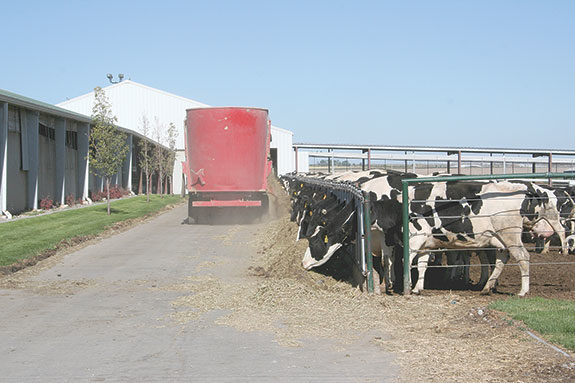You would simply end the year wondering why you did not have much left to show for all the work you did.
Sound familiar? In many ways that is the approach the majority of dairy producers take when it comes to managing their feed production and utilization, which arguably accounts for the majority of variable costs, and in many cases is the single-largest component of annual dairy cash expenditures.
The dairy farm as a manufacturer
A dairy farm can be viewed as a manufacturing operation with feed as the primary input and milk as the primary output, or product.
The feed is produced “in-house,” purchased or both, and then inventoried and subject to storage and feeding losses (shrink and waste).
It is then used for manufacturing other “inputs” (i.e. replacements) – predominantly a cost or production of a marketable output (i.e. milk) – the primary source of income or revenue.
In the manufacturing sector, inventory control and monitoring efficiency of use of key inputs are essential to both productivity and profitability. It is the one thing we have substantial control over.
It is no different for a dairy farm, yet estimates are that less than 10 percent of all dairy farms employ feed management, defined as at least tracking daily feed allocation.
With today’s feed costs and slim margins, it is arguable that use of feed management technology (the cost side) should be as widespread on dairy farms as is milk recording technology (the revenue side).
As occurred historically with milk recording, it may be that many are unaware of the feed management technology available today, how easy it is to apply and how cost-effective it can be to help dramatically decrease feed cost, as well as improve productivity and feed-related health problems.
Feed management technology
Feed management technology can be viewed as an expandable system that, at a minimum, starts with tracking the feed that is batched and delivered to individual groups of animals over time, and to which more advanced components can be added, as desired.
- The basics: A simple feed management system usually requires upgrading a standard TMR mixer scale indicator to one that has the capability to record ration formulas in memory, the weights of individual ingredients loaded during batching and the amounts of mixed rations unloaded to specific pens during feedout, all at the specific times each event occurs.
The scale indicator is matched with a dedicated (PC) software program used to compile and analyze the data, as well as update the rations in the indicator.
Finally, a portable memory module is used to transfer the data between the indicator and the PC. All together one can expect a basic system to add between $4,000 and $6,000 to the cost of a TMR mixer.
- Adding capabilities: Addition of more advanced capabilities will generally require further upgrades to both the scale indicator and the software, and some will require installation of additional computer hardware or weighing equipment.
These advanced capabilities can include weighing and reallocating feed refusals, periodic to real-time adjustment for moisture variation in ingredients, tracking of individual operator performance, radio communication and control of mixer information from a central office, management of multiple mixers and operators, digital pen controls to prevent incorrect delivery of feed, tracking of purchased feed inventory, measuring and tracking on-farm feed production and inventory, online access to feed management software and sharing with consultants, and integration of feed records with milk production records.
Advanced systems, which include operator supervision, consultant access and/or radio communication, can start at around $12,000 and easily range from $16,000 to $20,000. Most will require an annual service fee as well.
Obviously the value of any system will be proportional to the size and complexity of the operation. The challenge is to configure and size the system based on the needs and opportunities of each farm.
So, what use is it?
The old adage is true, “If you don’t measure it, you can’t manage it,” and when we are talking about managing 50 to 60 percent of the variable costs on the dairy farm, there is plenty of room for return on investment.
Normand St-Pierre, Ohio State University dairy extension specialist, calculated the November 2012 U.S. average feed cost for lactating and dry cows together as $6.81 per head per day.
This would translate into about $286,000 for milking an average of 100 cows per year. If the replacement animal feed costs were a third of milk production costs ($95,000 per year), total feed costs would be $381,000.
Thus, on an operation milking 100 cows, feed savings of only 1 percent could pay for a basic feed management system in as little as one year. One supplier of feed management solutions for larger operations states “their typical customers find their payback in six months.”
Returns on investment in feed management technology are achieved in the following ways:
1. More precise feed batching: The actual amount of each ingredient required for a batch of feed appears on the screen of the scale indicator and counts down as it is loaded, enabling more accurate weighing of ingredients, especially expensive supplements, than remembering numbers from sheets of paper and juggling calculations in one’s head due to missing the target additions from previous ingredients.
This means more consistent rations from day to day and less waste of expensive ingredients from oversupplementation, resulting in a potential savings of 1 to 2 percent of total feed costs by itself.
2. Predicting and tracking feed intake: Changes to the target amounts to be fed to each pen can easily be made on the scale indicator to match the number of animals being fed as they are added or removed, or scaled as a proportion of the total fed as overall intake changes.
First, this makes it much easier to match feed delivery to actual requirements and minimize both empty bunks and excess feed delivery. With more advanced systems it is also possible to weigh and reformulate refusals.
Second, it makes it easy to track average dry matter intake and easily detect shifts in intake that may be due to changes in moisture content of the ration.
Knowing actual dry matter intakes will assist the dairy nutritionist in formulating rations, as well as enable one to more accurately evaluate the formulation changes that are made.
Early detection of intake changes due to ingredient moisture fluctuation can minimize related production losses and health problems.
3. Improved performance and animal health: It is well known that variation in feed batching and times of delivery result in variation and losses in milk production. Most feed management systems report the variance between the target amounts of ingredients in a batch versus what was actually weighed.
They also record the times batches are made and delivered to the target pens. Analysis of this data can help tighten batching performance and delivery schedules, resulting in reduced ingredient wastage as well as improved performance and animal health.
4. Improving feed efficiency: Once feed batching and delivery to both the lactating and replacement herds are being tracked over time, it becomes possible to assess the economic impact and performance of each group of animals, and the efficiency of the rations being used – for example in regards to forage quality and nutrient density – since all relevant information will have been recorded (i.e. ration formulation, animal numbers, amount fed, time, production, etc.).
This becomes the basis for adjusting management practices, ration composition and use of specific ingredients to reduce inefficiencies and remove unnecessary costs.
5. Reducing feed cost through inventory management: Once the above has been established, it is not difficult to expand evaluation into other areas, such as inventory management.
For example, the purchases of a specific ingredient over time can be compared against the recorded usage in the rations that were fed, less current inventory.
A larger-than-expected deficiency in remaining inventory, beyond a reasonable expectation for shrink, might indicate the TMR mixer scale is underweighing (i.e. overusing) the ingredient and needs to be serviced.
On larger farms, inventory control is viewed as especially important and a truck scale is added to the system. All produced and purchased ingredients are weighed into and out of inventory and recorded within the feed management software. In this way, true feed production costs and shrink can be evaluated.
There was a time when on-farm milk recording and other record-keeping was deemed suitable only for the largest, managed dairy farms.
Now it is valued and used on average 100-cow farms, if not most farms. We are now at the point that the same should be said for feed management, especially now that the tools have become reasonably priced and generally available from most TMR mixer and related scale system vendors.
Do yourself and your business a favour; take the opportunity to investigate what is available and configure what you need to improve your profitability. Feed savings go straight to the bottom line. PD
PHOTO
There was a time when on-farm milk recording and other record-keeping was deemed suitable only for the largest, managed dairy farms. Now it is valued and used on average 100-cow farms, if not most farms. We are now at the point that the same should be said for feed management. Photo courtesy of PD staff.

- Alan Vaage
- Ruminant Nutritionist
- Jaylor Fabricating Inc.









